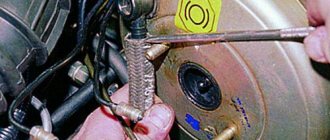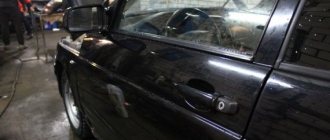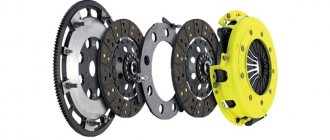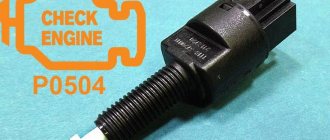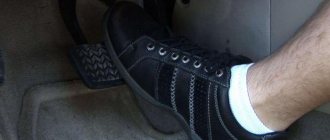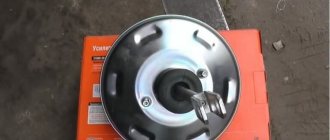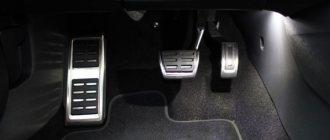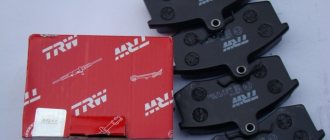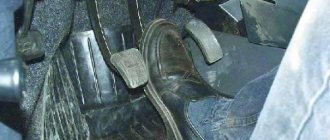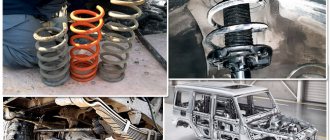Even such a simple operation as replacing brake pads is essentially a repair intervention in the most important safety system. You need to know all the subtleties and possible consequences of the process, which many people underestimate and, after completing the work, may be unpleasantly surprised by the consequences.
One of the troubles that appeared was the failure (softness) of the pedal all the way to the floor instead of the usual viscous and powerful braking.
In the article:
- The pedal has become too hard
- How to make sure the vacuum booster is working properly
- The brake pedal is too soft
- Results
The braking system is the most important component of any vehicle.
Automotive designers pay special attention to brakes, realizing that safety on the road and people’s lives depend on their impeccable operation. The brakes of modern cars are quite reliable, however, you need to remember that any parts during operation are subject to mechanical, thermal, chemical and other types of loads, and therefore wear out and may fail. Brake system parts are no exception, only in this case the cost of a malfunction can be very high. Certain signs that appear during braking can warn that something is wrong with the brakes - extraneous sounds or strong vibrations, the car pulling to the side, uneven or noticeably decreased braking efficiency and an increased braking distance. But the first thing people usually pay attention to is the behavior of the brake pedal. It can become too tight, so that you have to press on it with force, or, on the contrary, it can suddenly turn out to be too soft, or even fail completely. All this complicates braking and can lead to serious consequences. Let's talk in more detail about what causes such symptoms and what to do in such situations.
The pedal has become too hard
Sometimes a relatively tight brake pedal can be a feature of some car models. This nuance needs to be clarified if you have just purchased a car or are testing it before purchasing.
If everything was fine, but at some point you noticed that the pedal suddenly became “wooden” and you had to press on it with considerable force, then most likely the malfunction is related to the vacuum brake booster. It is this device that is designed to reduce the physical effort required to perform braking.
The ease of pressing the pedal occurs due to the difference in pressure in the atmospheric and vacuum chambers of the amplifier. Between the chambers there is a diaphragm with a rod that pushes the piston of the main brake cylinder (MBC), which, in turn, pumps brake fluid into the system lines and further to the working brake mechanisms. The vacuum in the vacuum chamber is created by an electric pump, and in gasoline engines the source of vacuum is often the intake manifold.
In the initial state, the cameras are connected to one another. When the pedal is pressed, the vacuum chamber is connected to the source of vacuum through a check valve, and the atmospheric chamber is connected to the atmosphere through an air valve. As a result, the diaphragm with the rod is drawn into the vacuum chamber. This reduces the force required to press on the GTZ piston. The vacuum amplifier can be made as a separate element or form a single module with the GTZ.
The most vulnerable element here is the rubber hose connecting the intake manifold to the vacuum chamber. Therefore, first of all, you should check its integrity and, if necessary, replace it.
Violation of tightness may be accompanied by non-standard behavior of the engine during braking - tripping, increasing or decreasing speed, sometimes fuel consumption increases. This is due to air leakage through a damaged hose and the entry of a lean mixture into the engine cylinders.
If the vacuum pump creates a vacuum, you need to check its serviceability.
In the vacuum booster itself, the air filter may become clogged, the diaphragm may be damaged, or one of the valves may lose mobility.
If necessary, you can purchase a new vacuum brake booster or try to repair the existing one. Be careful when disassembling - there is a spring inside, as well as a number of parts that can be easily lost. It must be borne in mind that during reassembly after repair it is not always possible to sufficiently ensure tightness, and therefore normal operation of the device.
When replacing the vacuum booster, it is not necessary to disassemble the turbocharger, and therefore there is no need to bleed the brake system.
The brakes can also become hard due to damage to the cuffs in the turbocharger or working cylinders and, as a result, a tighter stroke of the pistons in them. Treatment is to replace damaged parts or the cylinders themselves.
How to make sure the vacuum booster is working properly
First you should do a visual check. Make sure there are no brake fluid leaks and the booster housing is not damaged. Check the integrity of the hoses and the tightness of their connections to the fittings. If necessary, tighten the clamps.
A hissing sound that occurs when you press the brake pedal may indicate a leak. This hissing often persists for some time after the engine is turned off and then it can be heard quite clearly.
There are several ways to check the performance of the vacuum booster.
- The engine must be stopped. Press the brake pedal 6-7 times in a row to equalize the pressure in the booster chambers, and then squeeze the brake all the way and start the engine in this position. If the amplifier is working properly, a vacuum will appear in the system. Due to the pressure of the diaphragm, the rod will move, pulling the pusher along with it. And since the pusher is mechanically connected to the pedal, it will lower slightly, and this can easily be felt with your foot. If this does not happen, it means that a vacuum has not arisen in the system. If you have any doubts, try the second method.
- Turn on the engine, let it idle for a few minutes, then turn it off. Press the brake fully two or three times and release the pedal. If the vacuum booster is working normally and there is no air suction, then the first one or two presses will be soft, and the subsequent ones will be noticeably tighter. If you don't notice any difference in the pedal travel, then there is a problem with the amplifier.
- With the engine running, depress the brake pedal and, while holding it down, turn off the engine. If you now remove your foot from the pedal, it should remain in the lowered state for some time, thanks to the remaining vacuum in the vacuum chamber of the amplifier.
Self-diagnosis methods.
Depressurization of a vehicle can be determined immediately if the engine is running unstable - “troit”. This is caused by air entering the intake manifold. During such a failure, the air-fuel mixture entering the cylinder becomes sharply leaner. A sign of a faulty vacuum booster is also the hissing sound it makes. To specify the breakdown, you should press the pedal a few minutes after turning off the engine. If the pedal stiffness does not disappear, then most likely the check valve is broken.
If the vacuum booster is in good working order, the pedal that is “pumped” without starting the engine goes down when the engine starts running.
The brake pedal is too soft
If pressing the pedal has become too soft, it means there are air bubbles in the hydraulics and then the system should be pumped, or there is a loss of working fluid. The first thing you need to do is check the brake fluid level. If it is below the permissible level, the hydraulic system must be carefully checked for leaks. A leak may occur at the connection points between the tubes and fittings due to poorly clamped clamps, and the hoses themselves may be damaged. Working fluid can also be lost in wheel brake cylinders if the seals are damaged. After eliminating the leak, you will also need to bleed the brake system hydraulics to remove air from it.
If the brake fluid is of poor quality, contaminated, or has not been changed for a long time and has lost its properties, then heating during sudden braking can quite easily lead to its boiling, and then the brakes will become “wobbly” and the car itself will be difficult to control. An old, dirty, or inadequate brake fluid can cause seized brake cylinders, damaged seals, and other problems. The conclusion is obvious - pay attention to the condition of the brake fluid and change it in a timely manner.
Another reason for a soft brake pedal is the hoses, which are made of rubber and wear out over time, becoming loose. When hydraulic pressure builds up during braking, they simply inflate. As a result, the brakes become too soft and braking becomes less effective.
An extreme and very dangerous manifestation of soft brakes is pedal failure. This occurs due to significant leakage of fuel fluid or damage to the sealing rings in the gas turbine engine.
An excessively soft brake pedal, and even more so if it fails, requires an urgent solution to the problem. You need to stop immediately, braking with the engine or handbrake, and then find and correct the problems.
“In 90% of cases, these features are corrected, and the child can study in a regular school”
The initiator of the Dyslexia Belarus project, Valeria Bobkova, says that in the world, according to the WHO classification, dyslexia is classified as a “learning difficulty.” Children with this feature go to regular schools.
“However, there is a local difficulty here: very often such children are misdiagnosed and labeled as having mental retardation.” Then the child, who is absolutely normal in intellectual terms, is sent to a school for children with delayed development. I believe this is due to low awareness on the topic of dyslexia,” says Valeria Bobkova.
According to her, dyslexia is diagnosed at the age of five to seven years, in the UK - from the age of four.
- This is a feature, not a disease. Now there are many technical means that can maximally compensate for the inconvenience for people with such features: special fonts, screen color and text pages. Experts insist that with early diagnosis and qualified correction, these features can be made practically invisible to a person, notes the initiator of the Dyslexia Belarus project.
The photograph is used as an illustration. Photo: Alexander Chuguev
For dyslexics, there are programs to correct this feature. There are free programs on the websites of the International Dyslexia Association or the British Association.
“According to the European Dyslexia Association, in 90% of cases these features are corrected, and the child can continue studying in a regular secondary school,” continues Valeria Bobkova. — In the USA and Great Britain there are special schools for dyslexics. In addition, instead of a written exam, dyslexics often take an oral one; up to 20% more time can be allocated for written tests. The only centers in our country that can hardly be classified as dyslexia correction centers are centers for correctional and developmental education and rehabilitation. This is a government agency that exists in every district. However, there are currently only a few specialists on this topic, which is why there are problems with the diagnosis and correction of dyslexia in Belarus.
Results
Other problems with the brake system are also possible - wear or oiling of brake pads, discs and drums, jamming of wheel cylinders and caliper guides. But one thing is clear - the braking system requires serious attention. Regular inspection, prevention and replacement of the vehicle, immediate response to problems and timely troubleshooting will allow you to feel more confident on the road and avoid many unpleasant and dangerous situations.
Use only high-quality spare parts, and in order not to run into fakes, purchase them from trustworthy stores.
Handbrake
VAZ 2109 brake regulator
https://youtube.com/watch?v=OC10c-BVUvI
To adjust you will need:
- garage room with inspection hole,
- regular set of keys.
Let's get started:
- Engage forward gear.
- Place stands under the front wheels for safety.
- The rear suspension of the car must be jacked up and supported with reliable supports.
You need to start by checking the lever, which is located inside the car between the two front passenger seats. Raise it two or three clicks. When raised, one click is made, which means the handbrake cable is tightened. This leads to the rear drums being blocked by the brake pads. If more than 8 are done, then the cable is weakened and the handbrake does not work:
- With the handbrake on, go down into the inspection hole.
- Loosen the first lock nut on the equalizer.
- Tighten the second nut so that the cable is in a taut position.
- If necessary, on the contrary, release it.
- Check the operation of the lever. It should respond with two or three clicks.
Then tighten the first nut from the hole, tighten with two wrenches to get the effect of tightening two nuts:
- After this, turn off the parking system.
- Check the rotation of the rear wheel rims.
Make rotational movements with your hands. Their rotation should take place without a jerk, calmly scrolling along the axis of the car. The sound should come out rustling. Consequently, the adjustment of the vehicle's brake system was carried out successfully. The vehicle is ready for continued operation. The brakes can also be adjusted in a car workshop. You can entrust this work to specialists. But the motorist experiences reliability when this work is done independently. A car can be considered technically serviceable when it is independently inspected and repaired. He will never let you down in difficult, dangerous times. In addition, the price of repairs at service stations can be high. When doing the work yourself, you need to carefully watch the video. You also need to study the photos and, if necessary, take them to the repair site. Place it on a rack or in the back seat of the car. If necessary, review them again. Read the instructions for the operation and the location of the necessary structures. Finish the adjustment and check the work done on a free asphalt area.
